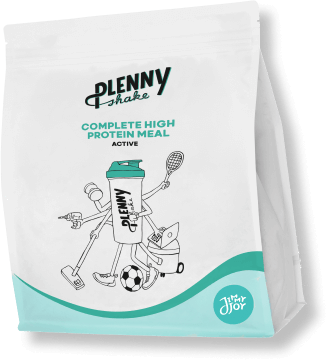You might have looked at articles and blogs, and got a little confused about all the science behind food. Therefore, this article is your go-to lexicon for understanding the principles of nutrition, and help you understand when which article is worth diving into at which point (spoiler: they are all worth it!)

Quick jump to sections:
- What are calories?
- How many calories do I need?
- What are Macronutrients (carbohydrates, fiber, protein, fats)
- What are Micronutrients (vitamins & minerals)
What are calories?
Calories, or strictly speaking ‘kilocalories’, are a measurement tool used to determine the energy content of foods. The energy in food is delivered by macronutrients, which vary in the number of calories they contain; a gram of carbohydrate and protein both yield 4 calories, while a gram of fat yields 9! So, what happens to that energy in our body? If you have heard of the law of conservation of energy before, it does not come as a surprise that a few things can happen. You either burn the calories by using the energy they provide and going wild in the gym, or the energy will be stored in the form of body mass (1–3).

How many calories do I need?
The number of calories necessary in your daily diet is composed of three factors.
Firstly, the amount of energy required to keep your body functioning when it is at complete rest, is called the basal metabolic rate (BMR). This is the energy you need for basic life-sustaining functions such as breathing, heartbeat and body temperature regulation. Secondly, the thermic effect of food (TEF) is the energy required for disposal, digestion and absorption of the food consumed. So yes, you basically burn calories while eating! Lastly, the activities of daily living (ADL) influence your energy-requirements. These are the calories needed to give you energy for day-to-day activities. This strongly depends on your lifestyle and physical activities. As you’d probably understand, going to the gym twice a day requires more energy than binge-watching your favorite series.

So how many calories should I eat when I want to maintain, lose or gain weight? Coming back to the law of conservation of energy, a different amount of energy can help you achieve your goals. When you want to maintain weight, you want to take in the same amounts of energy as the calories you burn. So, when your calorie expenditure is 2000 kcal, you would also consume this amount! In line with this theory, gain weight can be achieved by consuming more calories than you burn! On our Nutrition and Health page, you can read more about weight maintenance, weight gain and fat loss (1–3).
Macronutrients
Macronutrients make up the nutrients that need to be obtained daily and are used in large amounts. Hence, macro! As briefly pointed out before: they are the main energy deliverers in our diet. There are three groups of macronutrients: carbohydrates, proteins and fats. These groups should be responsible for respectively 40-70%, 10-35% and 20-40% of the calories in your diet. The exact amounts are strongly dependent on your lifestyle and goals! For an in-depth overview of the macronutrients, you can read this article about the macronutrients (1,2,4–6)!

Carbohydrates
Carbohydrates are the most important energy carriers in nutrition and are composed of the elements of carbon, oxygen and hydrogen. They are found in a wide spectrum of food products, both healthy and unhealthy. Carbohydrates can have both short and easy digestible structures, and longer and complex ones. Based on this, a distinction can be made in monosaccharides (glucose, fructose and galactose), disaccharides (lactose, sucrose and maltose), and polysaccharides such as starch. Did you know that all carbohydrates are built upon different combinations of monosaccharides? That is also how we yield energy from this source! All carbohydrates are broken down to glucose molecules by the body. These are extremely important because they provide the direct energy your body needs to function properly. More specifically, red blood cells, the brain and nerve cells can only use glucose as energy source, which illustrates how important they are!
When we talk about carbohydrates, it is the quality that matters. This means that an adequate intake is more focused on eating slow-releasing carbohydrates with a slow effect on blood glucose, rather than the short and easy ones that can lead to spikes.
In line with this, the recommended carbohydrate sources that fit a healthy diet are the complex ones, such as oat, rice and wholewheat products. Did you know that our products contain lots of these sources wherefore your blood glucose after a meal stays stable? You can read more about that here! (3,7–11)
Fiber
Although fiber might sound like a macronutrient on its own, it is a type of carbohydrate your body can’t digest for which they are not broken down to glucose molecules.
Instead, they contribute to a well-functioning digestion, a feeling of satiation after eating and reduce the risk of heart and vascular disease. Did you know that fibers are also the fuel for the microorganisms in our intestines? You can read more about that in this article! (1,3,11–13)
Protein
Proteins are essential in a healthy diet, being the foundation of all cells, the heart of all organic activity and important for the maintenance of muscle structures. Besides that, they are indispensable in production of hormones and enzymes. While proteins are mostly known for being visible as muscles, they are also present in bone, skin and hair!
Proteins are made from free building blocks called amino acids, for which different patterns translate to different proteins. In the digestive system, this food protein is broken down again into free amino acids. After breaking them down, they are built up again in the specific systems that your body needs at that moment! The process of breaking down and building up happens continuously. Did you know that half of your body protein is replaced in eighty days?

The amino-acids we just discussed, can’t be stored in our bodies for which we have to make them in two ways: by modifying others, or from scratch. Nine amino-acids, known as the essential amino acids, can only be obtained from our diets. As you might know, animal protein are the most complete sources, meaning they contain all essential amino-acids, while plant-based protein often lacks one or more essential amino acids.
By combining incomplete proteins, a complete protein intake can be established. Pairing rice and beans is the most common way to do so, and leaves you with all essential amino-acids. As an exception to the rule, soy protein contains all essential amino-acids for which it is an easy source to implement in your diet! You can read more about protein and the required amounts in this blog. (1,3,14–16)
Fats
Fat is one of your body’s main energy sources. As pointed out before, one gram of fat yields 9 calories per gram. Fats are important by delivering essential fatty acids your body needs for well-functioning of your brains and muscles. As you might know, we can divide it in three groups; unsaturated, saturated and trans fatty acids! Or more suitable; the good, the bad and the ugly! The most relevant aspect of the differences of these types is their overall impact that they can have on health. Unsaturated fats are known as the healthy kinds.

They have double bonds for which they are liquid at room temperature. They are well known for a well functioning brain. On the other side, you have the saturated fats which lack double bonds and are less healthful. Reducing saturated fat intake is linked with decrease in the risk of heart disease. Nevertheless, some kinds of saturated fats, called MCT’s might be healthful, and more studies are currently focussing on determining to which extent we should implement them in our diets. In contrast, trans-fats should be avoided at all costs. Luckily, due to regulation these types of fats are becoming less and less present, because our body does not know what to do with those. But let’s end on a positive note! The healthy fats have a positive influence on the well-functioning of our heart, which you can read more about here. (1,17,18)
Micronutrients
Micronutrients is the collective name for minerals and vitamins. In contrast to macronutrients, micronutrients do not provide energy and should be consumed in smaller amounts. Which doesn’t make them less important! Vitamins facilitate the release of energy from the macronutrients. Besides that, every vitamin has its own special roles to play when it comes to numerous activities throughout the body. Minerals are as important to consume in adequate amounts as vitamins. They influence fluid balance and are necessary for building structures such as bones and teeth. In this article, each micronutrient will be reviewed in depth! Did you know that vitamins and minerals are also key in maintaining a well-functioning immune system? You can read more about the science behind that in this article. (1,19)
Sources
- Whitney, E. N., & Rolfes, S. R. (2005). Understanding Nutrition. Thomson/Wadsworth.
- De Jong, F.M. (2016). Ons voedsel. Fontaine Uitgevers “Dietary Reference Intakes for Energy, Carbohydrate, Fiber, Fat, Fatty Acids, Cholesterol, Protein, and Amino Acids” at NAP.edu [Internet]. [cited 2020 Apr 5]. Available from: https://www.nap.edu/read/10490/chapter/12
- Eiwitten | Voedingscentrum [Internet]. [cited 2020 Feb 19]. Available from: https://www.voedingscentrum.nl/encyclopedie/eiwitten.aspx#blok7
- Vetten | Voedingscentrum [Internet]. [cited 2020 Feb 19]. Available from: https://www.voedingscentrum.nl/encyclopedie/vetten.aspx
- Koolhydraten | Voedingscentrum [Internet]. [cited 2020 Feb 19]. Available from: https://www.voedingscentrum.nl/encyclopedie/koolhydraten.aspx
- Slavin J, Carlson J. Carbohydrates1. Adv Nutr. 2014 Nov 3;5(6):760–1.
- Jenkins DJ, Wolever TM, Taylor RH, Barker H, Fielden H, Baldwin JM, et al. Glycemic index of foods: a physiological basis for carbohydrate exchange. Am J Clin Nutr. 1981 Mar 1;34(3):362–6.
- Lamothe LM, Lê K-A, Samra RA, Roger O, Green H, Macé K. The scientific basis for healthful carbohydrate profile. Crit Rev Food Sci Nutr. 2019 Apr 12;59(7):1058–70.
- Harvard Health. A good guide to good carbs: The glycemic index [Internet]. Harvard Health. [cited 2020 Apr 9]. Available from: https://www.health.harvard.edu/healthbeat/a-good-guide-to-good-carbs-the-glycemic-index
- Medicine I of. Dietary Reference Intakes for Energy, Carbohydrate, Fiber, Fat, Fatty Acids, Cholesterol, Protein, and Amino Acids [Internet]. 2002 [cited 2020 Apr 9]. Available from: https://www.nap.edu/catalog/10490/dietary-reference-intakes-for-energy-carbohydrate-fiber-fat-fatty-acids-cholesterol-protein-and-amino-acids
- Carlson JL, Erickson JM, Lloyd BB, Slavin JL. Health Effects and Sources of Prebiotic Dietary Fiber. Curr Dev Nutr [Internet]. 2018 Jan 29 [cited 2020 Sep 2];2(3). Available from: https://www.ncbi.nlm.nih.gov/pmc/articles/PMC6041804/
- Holscher HD. Dietary fiber and prebiotics and the gastrointestinal microbiota. Gut Microbes. 2017 04;8(2):172–84.
- Hoffman JR, Falvo MJ. Protein – Which is Best? J Sports Sci Med. 2004 Sep 1;3(3):118–30.
- Michelfelder AJ. Soy: A Complete Source of Protein. Am Fam Physician. 2009 Jan 1;79(1):43–7.
- Pendick D. How much protein do you need every day? [Internet]. Harvard Health Blog. 2015 [cited 2020 Apr 9]. Available from: https://www.health.harvard.edu/blog/how-much-protein-do-you-need-every-day-201506188096
- Harvard Health. The truth about fats: the good, the bad, and the in-between [Internet]. Harvard Health. [cited 2020 Apr 9]. Available from: https://www.health.harvard.edu/staying-healthy/the-truth-about-fats-bad-and-good
- WHO | Fats and fatty acids in human nutrition [Internet]. WHO. World Health Organization; [cited 2020 Apr 7]. Available from: https://www.who.int/nutrition/publications/nutrientrequirements/fatsandfattyacids_humannutrition/en/
- Harvard Health. Micronutrients have major impact on health [Internet]. Harvard Health. [cited 2020 Apr 9]. Available from: https://www.health.harvard.edu/staying-healthy/micronutrients-have-major-impact-on-health
 Everything You Need In One Meal
Everything You Need In One Meal
 Stay Full For 3-5 Hours
Stay Full For 3-5 Hours













 Product added to cart
Product added to cart





